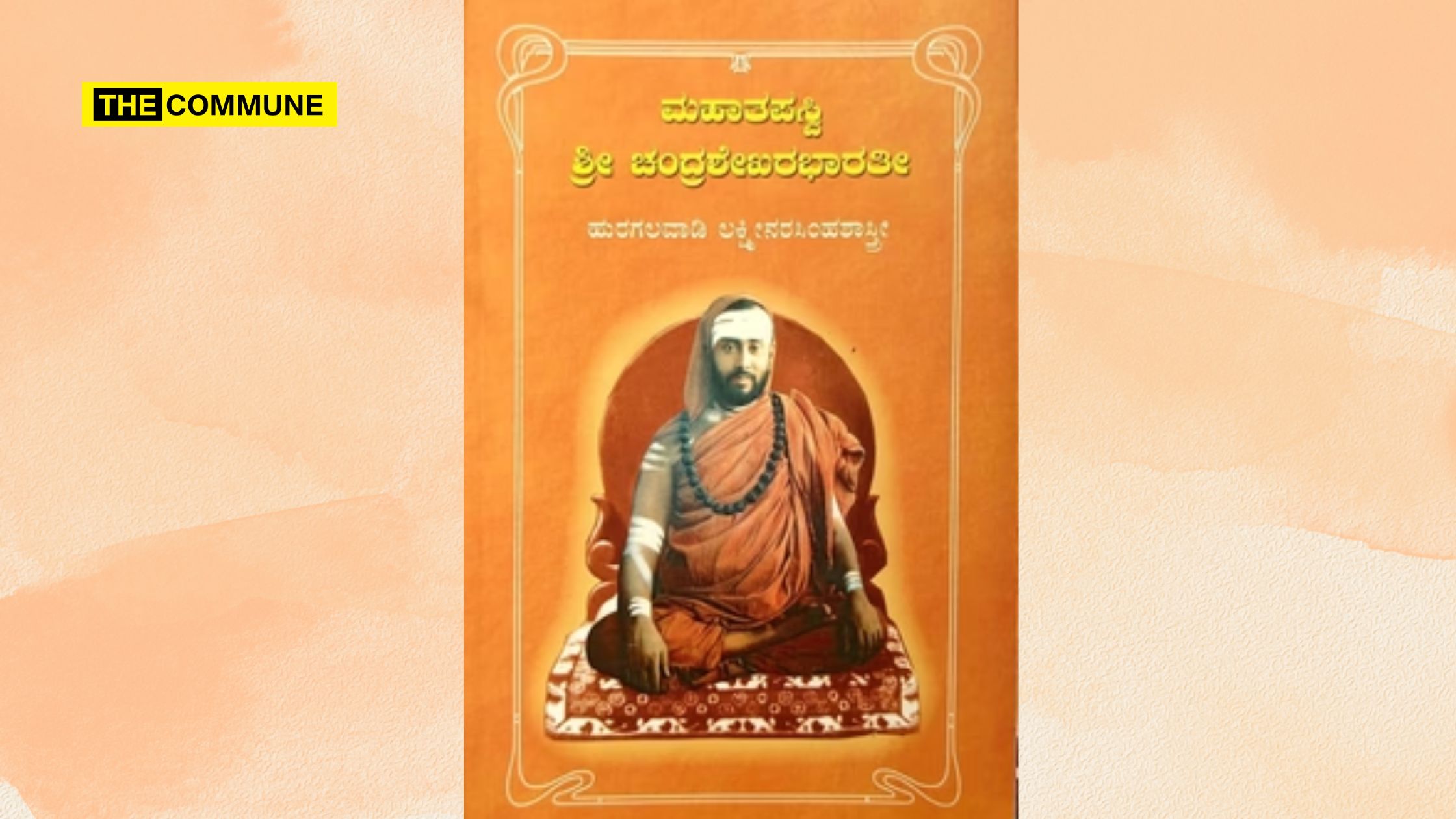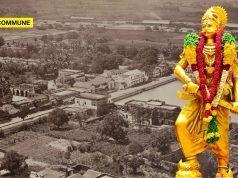
Sringeri has been an abode of eternal devotion and it’s not a surprise that the last year has found a renewed, growing reverence and attachment to the Vyakhyana Simhasana of Sringeri. With my humble namaskara at the holy feet of current Jagadgurus and Adi Shankara Bhagatvatpada, I would like to write about my personal experiences with reading and more importantly experiencing this book. Jagadguru Sri Chandrashekara Bharathi III is worshipped fervently over generations across the geography of this holy land. However, what amazes me is the fact that he continues to be the subject of immense study and evokes a deep interest amongst the asaktas alike across the spectrum.
This book, first published in 1964, provides a very deep insight into the life and times of the very revered and worshipped Jagadguru. This is perhaps one of the first accounts of Jagadguru’s life in Kannada, with references to multiple works like “The Saint of Sringeri” & “Sparks from the Divine Anvil” by R. Krishnaswamy Iyer (also known as Sri Jnananda Bharathi Swami). There are other works on the life of Jagadguru Sri Chandrashekara Bharathi by other prominent authors like Prof. S. K. Ramachandra Rao that provide a uniquely different perspective on the life of the Jagadguru.
One of the major highlights of this book is the very comprehensive history of the Sharada Peetam with a very good insight into the various Jagadgurus starting from Adi Shankara Bhagavatpada. The book comprises some wonderful verses throughout the book. The book details the life of Adi Shankara including his pravara (Atri Gotra, Yaju Shakya) and details his journey through the holy land of Bharatvarsha, establishing the 4 peetas – Sharadha Peeta (Sringeri), Govardhana Peeta (Jagannath kshetra – Puri), Kalika Peeta (Dwarka) & Jyotir Peeta (Badrinath).
One of the very interesting insights into Sringeri is the fact that Chandramoulishwara Linga and Ratnagarbha Ganapati are considered to have been brought from Kailasa. Detailing the various Gurus in the unbroken parampara, the book details the rejuvenation of the Adhyatma during the times of Vidyateertha, Bharathi Teertha & Vidyaranya Swamigal. The contributions of the various rulers of the region across centuries including Hyder Ali and Tipu Sultan make for a fascinating read, for the book not only expounds the spiritual and dharmic side of the matha, it also provides a very interesting picture of the historical events that occurred during the same time.
In other words, this book becomes an excellent socio-cultural-historical account of the land across centuries. The life and times of Jagadguru Sri Narasimha Bharathi VIII (also known as Sri Ugra Narasimha Bharathi) & the journey of Shivaswamy to become Jagadguru Sri Sachidananda Shivabhinava Narasimha Bharathi (also known as Abhinava Shankara) are captured in luminous terms, especially the establishment of Samskrutha Sanjeevani pathashala, identifying Adi Shankara’s birthplace at Kalady and getting a temple constructed at the site etc.
The book then provides the biographical sketch of Jagadguru Sri Chandrashekara Bharathi III Mahaswamigal. When one reads the trials and tribulations of the parents of Mahaswami in his poorvaashrama days i.e. Gopala Shastry and Lakshmamma, one is bound to find very deep empathy at the couple who would have lost 13 children just after their birth. When they decide to embark on a teertha yatra, they are blessed by Bhagwan Mahabaleshwar at Gokarna.
At this juncture, the author provides one of the most magnificent and comprehensive descriptions of Malenaadu’s ethereal beauty. Gopala Shastry and Lakshmamma are blessed with a boy who is named Sri Narasimha. The divine role in guiding the life of the young Vatu is observed at every step with the sitting Jagadguru taking a deep interest in the studies and progress of the young prodigy. Later, it can be observed that Jagadguru had chosen Narasimha as his successor in a very divine composition wherein every verse ends with “sarvajñanaṁ śrī nr̥sinhaṁ kuru śivadayitē “.
When the sitting Jagadguru i.e. Abhinava Shankara attains Mukti owing to age-related issues, the young Narasimha is brought to Sringeri and ordained into Sanyasa as per the wishes of the late guru. It needs to be observed that this decision wasn’t necessarily agreeable to all parties, but the ruling Mysore Maharaja, Sri Nalwadi Krishnaraja Wodeyar IV, ensured that the wishes of the Jagadguru were respected and adhered to by all related stakeholders.
The studies of the young Jagadguru were facilitated by very reputed scholars in all streams related to Dharmashastra. However, Jagadguru Sri Chandrashekhara Bharathi III swami would meditate near the vana of his predecessor and Guru and would be able to find solutions to complex problems running in the mind. This form of Guru-Sishya communication would become a recurring theme throughout the book and also is one of the miraculous qualities attributed to the Jagadguru even today.
The rest of the book provides a very detailed insight into the various tours undertaken by the Jagadguru in spreading the message of Dharma across the land. However, the book is also replete with miracles associated with the Jagadguru. One such example is the Swami speaking in chaste Tamil on his very first tour to Tamil Nadu given he had no prior exposure to the language. The author uses excellent metaphors to describe the spiritual and cultural interconnect between geographical boundaries attributing the flow of 2 teerthas – Physical Kaveri and Jnana Ganga from Sringeri.
The book later describes the gradual withdrawal of Mahaswami from the daily functions of the matha and intensifying his sadhana toward self-realization. His trance-like demeanour is considered to be abnormal by many close associates, who hire a reputed doctor to check on the Mahaswami. What is supposed to be a scientific investigation turns out to be a humbling, but enlightening exercise to the respected doctor.
The book also details the selection of Sri Srinivasa as the successor and later ashramapravesha as Jagadguru Sri Abhinava Vidyateertha Mahaswamigal. After Sishya sweekara, the sitting Jagadguru’s withdrawal from routine life and focussing more on sadhana becomes much more intensified, as he is released from the chains of responsibility. Though he does come out of his Avadhuta-like trance sadhana and graces the audience with renowned scholars and leaders like Dr. Rajendra Prasad, and Dr. Sarvepalli Radhakrishnan, he is more focused on remaining a recluse & prefers not to come in full public view.
There are more miraculous events attributed to the Mahaswami like enabling the Nepal king to reclaim his kingdom or being able to view and perceive the pain of people suffering from floods in Kerala when no one was even aware of such an event occurring at that time. Jagadguru Sri Chandrashekhara Bharathi III believed in focusing on one’s own sampradaya and didn’t appreciate conversions or oneupmanship across sampradayas. He was widely respected by people of all faiths and beliefs cutting across the spectrum. The final moments of his life where he decides to give up his mortal coil through Yoga are really hair-raising & quite shocking. The book concludes with a good chapter on the reigning Jagadguru of that time i.e. Jagadguru Sri Abhinava Vidyateertha and the continued work on various dharmic and social activities.
The book is such a wonderful gem that it’s a literal field of diamonds i.e. diamonds of timeless, eternal knowledge. Jagadguru always emphasized that one needs to perform sadhana to discover the Guru within oneself. If we can comprehend and assimilate even a fraction of Jagadguru’s teachings, life and society will be a much better place. A very divine and very highly recommended read.
Personal Note: I was lucky and blessed to receive the first edition of the book from Sri Ramprasad K V, whose parents originally owned the book. I can’t express enough my immense gratitude for blessing me with such a wonderful masterpiece.
Gee Vee is an engineer and avid fan of itihasas, puranas and books.
Subscribe to our Telegram, WhatsApp, and Instagram channels and get the best stories of the day delivered instantly.




